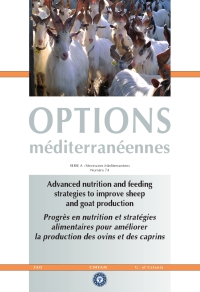| Article précédent | p. 107-112 | Article suivant |
Influence of goat livestock systems on the performance of Cilentana kids
Thirty goats were equally divided before parturition into two groups (A and B) homogeneous in parity and milk production at the previous lactation. Group A (control) was housed in stall conditions, while group B was led to pasture and raised following EU Regulation 1804/99 on organic farming. Both groups received diets with the same energy and protein contents (1.03 UFL/kg DM; 18% DM of CP). The kids were weighed at birth, at 25 days of age and at slaughter (mean age 60 days). On six kids from each group, body measurements before slaughter and carcass measurements, after 24 hours of refrigeration, were taken and dressing percentages were calculated. The right hind leg of each animal was dissected to calculate meat, fat and bone percentages. Finally, the meat water-holding capacity was evaluated. No significant differences were found between the groups, suggesting the effectiveness of organic livestock production systems.
Trente chèvres ont été divisées avant la mise bas, en deux groupes égaux (A et B) homogènes en numéro de parturition et production de lait lors de la lactation précédente. Le groupe A (témoin) était logé en stabulation, tandis que le groupe B était mené en pâturage et élevé selon la réglementation 1804/99 de l'UE sur l'agriculture biologique. Les deux groupes recevaient des régimes ayant les mêmes teneurs en énergie et protéine (1,03 UFL/kg MS ; 18% PB MS). Les chevreaux étaient pesés à la naissance, à 25 jours d'âge et à l'abattage (âge moyen 60 jours). On a effectué sur six chevreaux de chaque groupe, des mesures corporelles avant l'abattage, ainsi que des mesures sur la carcasse, après 24 heures de réfrigération, et on a calculé les pourcentages de rendement de la carcasse. La jambe arrière droite de chaque animal a été disséquée pour calculer les pourcentages de viande, gras et os. Finalement, la capacité de rétention d'eau de la viande a été évaluée. Il n'a pas été trouvé de différences significatives entre les groupes, ce qui suggère l'efficience des systèmes d'élevage biologique.
- [ Afficher ]
- [ Télécharger ]
- [ Exporter la citation ]
Vous pouvez télécharger la citation au format :
- [ Imprimer ]
-
Mots-clés
AGRICULTURE BIOLOGIQUE, APTITUDE POUR LA VIANDE, CHEVRE, CHEVREAU, COMPOSITION DE LA CARCASSE, EXPERIMENTATION, PATURAGE, PERFORMANCE ANIMALE, REGIME ALIMENTAIRE, STABULATIONCiter cet article
Cutrignelli M.I., Tudisco R., Bovera F., Piccolo G., D'Urso S., Infascelli F. Influence of goat livestock systems on the performance of Cilentana kids. In : Priolo A. (ed.), Biondi L. (ed.), Ben Salem H. (ed.), Morand-Fehr P. (ed.). Advanced nutrition and feeding strategies to improve sheep and goat . Zaragoza : CIHEAM, 2007. p. 107-112. (Options Méditerranéennes : Série A. Séminaires Méditerranéens; n. 74). 11. Seminar of the FAO-CIHEAM Sub-Network on Sheep and Goat Nutrition, 2005/09/08-10, Catania (Italy). http://om.ciheam.org/om/pdf/a74/00800363.pdf



